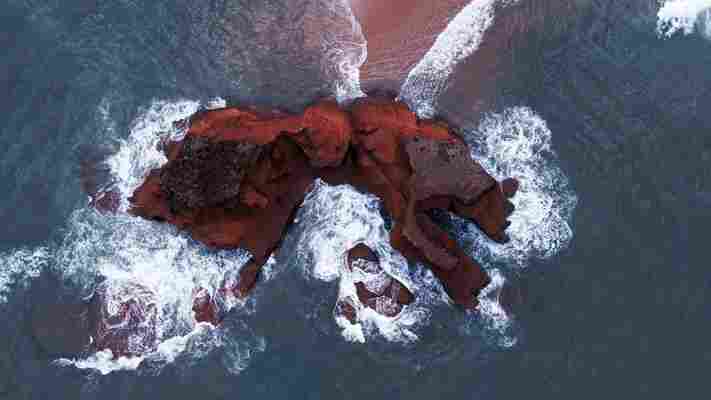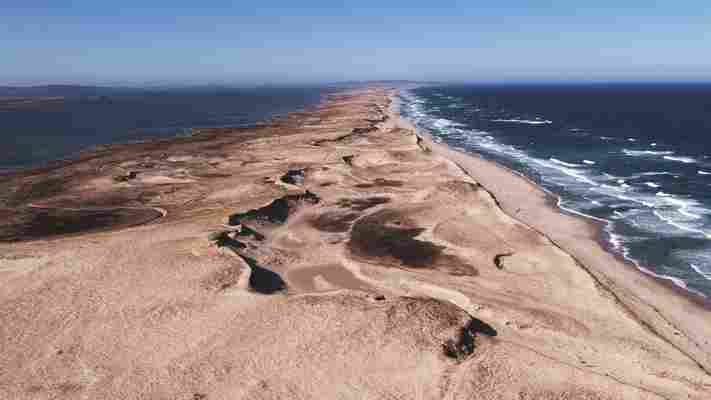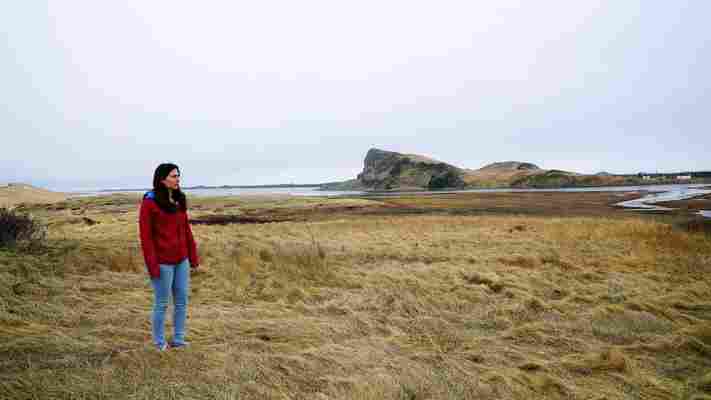Article continues below

(Credit: Uladzimir Taukachou)
Peter Alexander Tager was a stowaway on the Good Intent, a Liverpool cargo ship carrying a load of timber back to England from Quebec. The Brophys set sail on an Irish famine ship called the Miracle, carrying hundreds of immigrants to a hopeful new life in Canada. Robert Best was returning to the Channel Islands on the Perry, a ship loaded with salt cod from the port of Gaspé.
They all set sail for different reasons but they all succumbed to a similar fate: their ships were violently thrown off course and ultimately consumed by the sandy beaches and shallow waters of the Magdalen Islands (Les Îles de la Madeleine in French) in Canada’s predominantly French-speaking province of Quebec.
Isolated in the middle of the Gulf of St Lawrence, the fishhook-shaped archipelago was an unexpected and dangerous landmass in the way of ships sailing between Europe and Quebec. An estimated 500 to 1,000 vessels fell victim to its whims, mostly in the 18th and 19th Centuries.
“Many of them didn’t even know that an island was there,” said coastguard Charles Cormier. “Once, 48 ships sank during a single storm.”

(Credit: Uladzimir Taukachou)
In those days, there were few lighthouses or accurate charts, and heavy winds, fog and rocky waters made navigation a game of guessing and dexterity. As a result, many passengers perished and were buried among the sand dunes. Only the most resilient survived, ultimately forfeiting their intended journeys and building a new life along the islands’ tempestuous shores.
Today, many descendants of these survivors, like 32-year-old Nancy Clark, still reside on the islands and find it hard to leave, despite the challenges they face. They are strongly rooted here as part of a tiny English-speaking community, within a French-speaking world, that lives to tell the tales of the generations of islanders that have come before them.

(Credit: Uladzimir Taukachou)
We’re such a small community, probably almost everybody can trace themselves back to at least one person who came here by shipwreck, Clark said.
(Credit: Uladzimir Taukachou)
In the mostly French-speaking islands, there are approximately 550 English-speaking residents, descendants of people who came from England, Scotland and Ireland. Many of them were immigrants, while others were passengers on cargo ships who decided to stay after they were shipwrecked. Most settled in three communities: Grosse-Île and Old Harry in the archipelago’s north, and Entry Island (Île-d'Entrée in French), a small island in the south only accessible via ferry. For these residents, their ancestry is tied to the islands, allowing them to retain a strong cultural identity.
Many even share the same last name. In Old Harry, most surnames are either Clark or Dunn. In Grosse-Île, one of the most common family names is Clarke instead of Clark, opening a spelling debate. People in Old Harry say that people in Grosse-Île added the ‘e’, while people in Grosse-Île believe people in Old Harry dropped the final vowel.
The French- and English-speaking communities preserved their distinct identities throughout the years. Until the 1970s, there was little intermarriage between the two groups, and each community had its own church, Catholic or Protestant, and its own schools.
“The English would stay in their community, and the French would stay in their community,” said Winston Clarke, a resident of Grosse-Île. “I’m not saying there was anything hostile. It was difficult to travel between the communities back then; there were no roads in the early 1900s.”
(Credit: Uladzimir Taukachou)
There are a few simple ways to tell the communities apart. For example, in the English areas, the houses are painted in muted shades of white and grey, while the French use bright yellows, greens, blues and even oranges. Clark also notes subtle differences in expression, such as how the Francophones tend to kiss and touch each other, while the Anglophones are a bit more conservative. “We’re more ‘nod your head’ type of people,” Clark said.
Despite the Magdalen Islands' distinctive identities, Clark – who works at the local school and develops projects to keep the Anglophone youth from leaving for bigger cities in Canada – sees strength in the commonalities that are present to this day.
(Credit: Uladzimir Taukachou)
I wouldn’t say there are huge differences – we notice the differences, but I don’t know if anyone else would notice because we’re all islanders and we all share so many things in common, Clark said.
(Credit: Uladzimir Taukachou)
There’s more to the area’s houses than colour and tradition, however. Some were constructed from shipwreck materials, like the Old Harry home of Rhoda Clark, Nancy Clark’s great-aunt, whose ancestors helped the survivors of the Miracle, which wrecked in May 1847. Rhoda explained how her house is part of island history, handed down through the generations of her family.
“My great grandfather Henry Sr Clark put together the old house here out of some shipwrecks, he put [it] together with some wooden pegs in the attic. In 1861, he built it… he walked up the beach and that’s how he built it, piece by piece.”
Also in Old Harry, the St-Peters-by-the-Sea church is 100 years old and was also built from shipwreck wood. “We wanted to make sure we kept the building and kept it in the community to make sure it wouldn’t be sold,” Clark said. “So we’ve developed a project that’s also very meaningful to the community.”
The church will host a portrait exhibition of islanders who passed away in relation to water during the 20th Century. Clark started collecting photos of the victims because she realised that death by sea affects most families here in one way or another. She has gathered 135 portraits so far; most of them were taken after the 1950s.
(Credit: Uladzimir Taukachou)
My passion for shipwrecks started long ago. I’ve been diving for 37 years. Nobody helps me, I do it for the passion. Because I love it, said coastguard Charles Cormier, who has no ancestral ties to the survivors but has made finding these ships his life’s obsession.
(Credit: Uladzimir Taukachou)
Many of the Magdalen Islands’ shipwrecks are hidden at the bottom of the sea in various states of decay; often all that’s left are pieces of wood. But a few wrecks are still visible from the beach, such as the Corfu Island, once owned by Greek magnate Aristotle Onassis, which sank off the shore of the Magdalen Islands in 1963 and lies aground on the beach, its hull stuck in the sand.
“Everyone was saved,” Cormier said. “The ship was carrying a load of green paint. The islanders took the paint and they painted many houses on the island; that’s why so many houses were green.”
(Credit: Uladzimir Taukachou)
The Magdalen Islands is a place of stark contrasts: a sunny day can quickly turn into a storm, and the beauty of the sea can quickly translate into danger – especially during fishing season when fishermen can be on the water for up to 12 hours a day.
“Sometimes in the winter when it’s very windy and very bleak, it can be a bit tough. But the summer makes up for all that, when we have beautiful weather and it’s the most serene, peaceful place you could ever be,” Clark said.
(Credit: Uladzimir Taukachou)
The Magdalen Islands may forever be menaced by the sea. According to the University of Québec in Rimouski, 70% of its exterior coasts are at risk of submersion, contributing to a loss of 0.75m every year. Some residents have had to move their houses away from the cliff’s edge in recent years.
Nevertheless, much has changed for the good, especially since the 18th and 19th Centuries when there weren’t adequate lighthouses to guide ships to safety, as Captain Edward Boxer (and shipwreck survivor) wrote in 1828:
“On this sea, navigation is so dangerous because of strong and irregular currents, and there is not a single lighthouse in all the Gulf. It is truly lamentable to find so many shipwrecks at different places on the coast... the number of lost lives is very large and certainly incalculable…”
His and other captains' complaints were finally heard. The first Magdalen Islands lighthouse was built in 1870 on Bird Rock, 32km northeast of Grosse-Île. Today, six lighthouses work together with detailed charts, GPS and other modern navigation methods to make these fragile and beautiful islands a much easier and safer adventure for people sailing near them – and for those who chose to make a life here.
